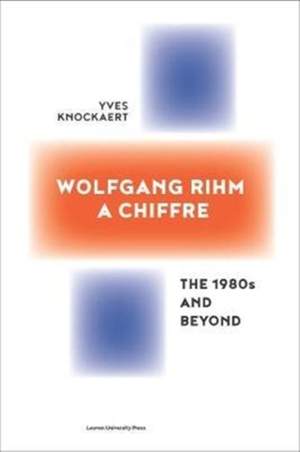Book
$87.75Out of stock at the UK distributor
Contents
- Foreword by Richard McGregorIntroduction Analysed Compositions
- Part I - Style 1 Between Classical and Individual Individual Position Specific Terminology and Tools Generative Pole and Generated Elements Generative Pole versus Rewriting and Overwriting Fragmentation Disturbance Single Event Focal Pitch and Focal Pitch
- 2 Between Modernism and Postmodernism Position towards Postmodernism Position towards Modernism Musical Backgrounds in Modernism and Nineteenth Century Philosophical Influences in Postmodernism Philosophical Influences in Modernism
- 3 Musical Traces Dealing with Allusion and Quotation Verbal Allusions in the Chiffre Cycle Allusion to a Style: Baroque Allusion to a Composer: Varèse Allusion to a Composition: Schubert’s Octet
- 4 Fine Arts The Music of Painting Fine Arts Parallels: Different Viewpoints Fine Arts Parallels: Rihm’s Viewpoints Line Drawing Colour Layering and Overpainting Large Drawing Kurt Kocherscheidt The Sound of Wood
- 5 Repetition Create a State by (non-)Repetition Repetition as Questioning Repetition as Writer’s Block Repetition as Unique Event Repetition versus Generating Elements Repetition in the Context of Style
- 6 Nature and Proportions Rhizome Proportions in Nature Symmetry and Balance Proportions in Music
- 7 Studying Proportions Dis-Kontur, Sub-Kontur and Klavierstück Nr. 4 Schwebende Begegnung String Quartet no. 4 Proportion Typology
- Part II - Analysis 8 Integrated Approach Sound as a Whole Some Examples Integrated Analytical Tool Moment Analysis of the Chiffre Cycle
- 9 Parameter Characteristics Melody Melodic Compositions Melodic Element Harmony Metatonality Micro-interval Dissonance The Tritone-Triad Chord Chain Cluster Informal Harmony and Texture Tempo – Metre – Rhythm Dynamics – Articulation – Timbre Youth Experi
- 10 String Quartet in the 1980s: String Quartets nos. 5-8 Aesthetic viewpoints Group Formation versus Individual Quartets Common First Note f# The Importance of Pitch f# Transitions in String Quartet No. 5 Transitions in String Quartet No. 6 Transitions i
- 11 Group Formation: Chiffre Cycle The Meaning of “Chiffre” Chiffre: a Cycle
- 12 Chiffre Cycle: Harmony The Tritone-Triad Chromatic Cluster Harmonic Rhythm and Chordal Density Consonance versus Dissonance Focal Pitch
- 13 Chiffre Cycle: Resonance Chiffre I: Resonance Space versus Sound Space Chiffre IV: Resonance Research Chiffre VIII: Meta-resonance Sound Space
- 14 Chiffre Cycle: Cyclic Elements Cyclic Elements: Typology Repeated Passage Overwritten Passage Repeated Single Instrumental Part Cyclic Elements: Similar Event Returning Concept Cyclic Elements: Three Figures Figure 1: Generated Elements Figure 2: Gene
- 15 Chiffre Cycle: Symmetry Melodic Symmetry Rhythmic Symmetry Time Signature Symmetry Harmonic Symmetry Total Symmetry Symmetrical Placing
- 16 Chiffre Cycle: Proportions Tempo Indications Tempo Changes Time Signature Proportions in the Chiffre Cycle Proportions in Chiffre I Proportions in Chiffre II Proportions in Chiffre III Proportions in Chiffre IV Proportions in Bild Proportions in Chiff
- Final Conclusions Appendix – Division in Sections Notes Selected Bibliography General Index Index of Compositions by Wolfgang Rihm



